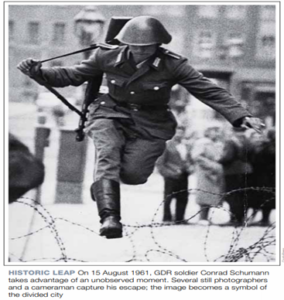
CWP Blog | CWP
Talk to Terrie: A Country (and City) Divided
August 4, 2021
August 4, 2021
CWP
CWP Blog
Many of you who are reading this grew up during the Cold War. We heard in school and from the news about different events that were happening around the world. But it’s unlikely that one would remember everything, especially if you were not yet a teenager. That’s how it was for me when it came to understanding the situation in Germany when I was young.
After Germany was defeated in WWII, the occupation of the country was divided between four of the Allied nations – the United States, England, France controlled Western Germany and the Soviet Union the East.

East Germany was losing many citizens for a variety of reasons. For some, it was personal. They were separated from their families and wanted to be reunited. Others saw that West Germany was recovering from the war better than East Germany and wanted to enjoy the better economic opportunities. Still others sought to escape the oppression they experienced under the Communist’s rule.
An estimated 12,000 people left East Germany per month in the early years. The Soviet Union decided it needed to stop the flow of refugees which was draining the workforce. In 1961, they decided to erect a barricade both through the entire county and in Berlin. Berlin was also divided among the four countries.
We learned of the many daring and sometimes fatal escape attempts of people living in East Germany after the walls and other barricades were installed. As many as 5,000 people escaped after the physical barriers separating East and West Germany was erected.

It is estimated that 200 people died trying to escape East Germany. “Growing up in the shadow of the Wall, West Berlin children play ‘border police and defector’ rather than cops and robbers. Their games mimic reality so closely that the ‘defector’” is often ‘shot dead’.
There were access points where travel between the West and East was permitted if the individual had the proper authorization. The most famous was Checkpoint Charlie, located in Berlin. Germans were not permitted to use this passage through the Berlin Wall. It was used mainly by tourists, military and diplomatic personnel from both sides. Checkpoint Charlie had its share of escape attempts. One successful attempt proved that love can conquer all.
In 1962, an Austrian man who worked in East Berlin fell in love with a woman who lived there. He identified a weak spot in the security at Checkpoint Charlie. He decided the best way to get the woman and her mother out was to remove the windshield of a convertible sports car and deflate the tires. He memorized the layout of the road leading to the checkpoint. With his girlfriend in the back seat and her mother in the trunk, he traveled at high speed and ducked underneath the security bar that blocked the exit.
The Berlin Wall came down on November 9, 1989. The process to reunite both Germany’s began shortly afterwards.
